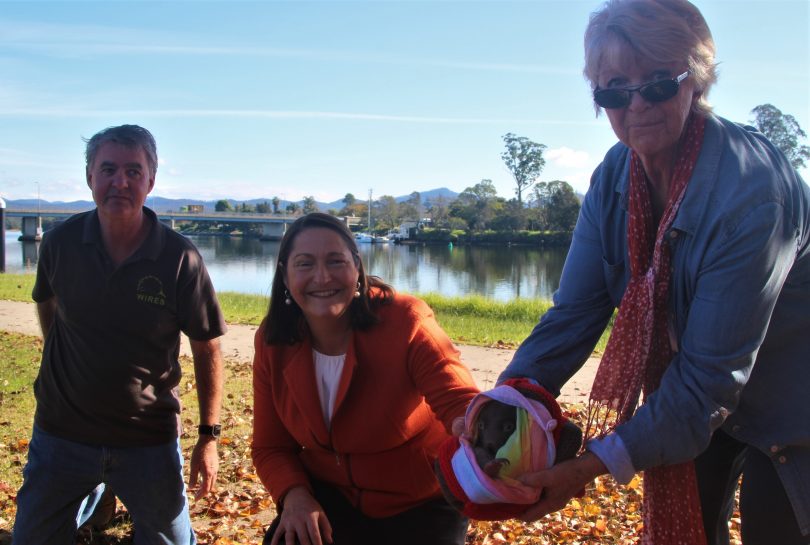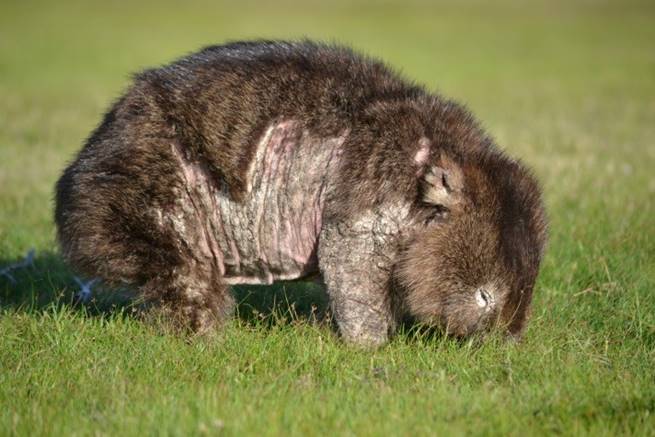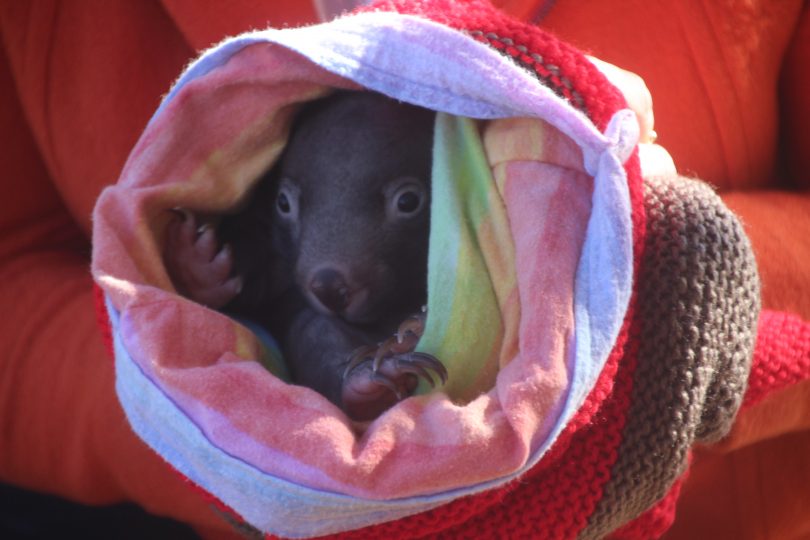
From left: WIRES volunteer Tom de la Fosse, Member for Gilmore Fiona Phillips, and WIRES specialist carer Velda Paterson with little Neddie the wombat. Photo: Alex Rea.
Federal funding through the Communities Environment Program has been provided to WIRES Mid South Coast Branch to implement a wombat mange treatment program across the Eurobodalla Shire.
Federal MP and Member for Gilmore Fiona Phillips was in Moruya on Tuesday to meet WIRES volunteer Tony de la Fosse, WIRES specialist carer Nelda Paterson and little Neddie the wombat.
“The South Coast has experienced a harrowing year that has impacted local people and our environment like never before, so I am thrilled to be announcing so many wonderful projects today,” said Ms Phillips.
Mr de la Fosse said, “The grant is fantastic news and will allow the group to expand the wombat mange treatment program across the region. We have noticed mange is particularly bad in the wombat population around Moruya and up the Deua River Valley. The good news is that wild wombats can be treated for mange.

A wombat with mange, a type of skin disease caused by parasitic mites. Photo: Wombat Protection Society of Australia.
“Mange is caused by the sarcoptic mite which burrows into the wombat’s skin where it lays its eggs. Eventually, it will cause the death of the animal. The good news is that wild wombats can be treated for mange.
“The main problem is how to find and access these animals, and we need landowners’ help. We can supply the expertise and chemicals to treat these wombats, but only if we can find them. The treatment is relatively simple and will save the animal’s life. If you have wombats on your property and you think they may have mange, please get in contact with us.”
Funding provided under the grant will allow the implementation of a mange treatment program for infected animals, which involves using the existing approved pesticide (Cydectin) to kill the mange mite.

A wombat with mange being treated. Photo: Wombat Protection Society of Australia.
The program includes running a public awareness campaign and implementing a property owner stewardship program where WIRES volunteers will work with landowners to treat infected wombats. Funding will also allow new technologies to be used to better provide Cydectin doses to the wild wombat population.
What is mange?
Mange is one of the biggest threats to Australian wombats. It is caused by a burrowing parasitic mite, Sarcoptes scabiei. It can wipe out wombat colonies in just a few years, is geographically widespread and affects thousands of animals across Australia.
Native mammals that are known to be affected by mange include ringtail possums, brown bandicoots, koalas and wombats.
The mite is easily spread, mainly by foxes which spread it between burrows and populations of wombats. With the mite living for about three weeks, it infects any animals that enter the burrow. Because wombats and foxes share burrows, it is easily spread.
Mange infection in an animal can result in aggressive scratching, hair loss, skin thickening and crusting, skin discoloration, open wounds (from scratching), weight loss, and, in severe cases, death as a result of secondary infection and suppressed immune system.
Left untreated, mange results in a slow and painful death for the animal.
How prevalent is mange in the Eurobodalla Shire?
Mange is widespread across the wombat population in the Eurobodalla Shire. It is particularly bad around Moruya and along the Deua River Valley, but is also present in many other areas.
How do you identify a wombat with mange?
Indications of mange are often first seen around the eyes and on the sides of the wombat, usually in a “ribbed” pattern.
The wombat suffers from the aforementioned itching, hair loss, skin thickening and crusting, with the resultant scratching causing damage to the skin. The wombat will scratch so much that it exposes raw flesh, creating wounds and scabs.
The wombat often becomes blind and deaf due to crusting around the eyes. The animal needs to come out of its burrow to eat during the day and keep up its energy. If not treated, the animal dies a slow and painful death.
Can mange be treated?
Yes, individual wild wombats and other animals can be treated for mange if they can be found. As with many wild animals, the challenge is to find them. It’s not recommended to capture wild wombats. The preferred method is treating them in the wild.
Effective treatment of mange in wombats requires a weekly dose of the chemical moxidectin (Cydectin) which is administered to the animal’s skin. There are several different methods of administering the chemical, including using a “burrow flap” where the wombat receives a dose as it enters and exits the burrow.
There is also a direct application technique where the chemical is applied straight onto the back of a wombat via a scoop attached to a pole.
How can WIRES help?
WIRES volunteers can support landowners to treat wombats on properties. WIRES has the expertise, equipment and chemicals to support their efforts to ensure wombats are mange-free.

Baby wombat Neddie in the care of WIRES volunteer Nelda Paterson. Photo: Alex Rea.
How landowners can help?
Spread the word that there is now a simple treatment program available to treat mange in wild wombats. Landowners can work with WIRES to treat wombats on private properties. The public can also report any sightings of infected wombats to WIRES.
Landowners who have wombats with mange on their property should call WIRES on 1300 094 737, or Tony de la Fosse on 0414 965 644 to discuss how WIRES can provide support to ensure wombats on their property are mange-free.








